
9 Modified Cars in India: Track Test
Can you really have fun without breaking the bank? We’ve all had posters of Ferraris and Lamborghinis up on our bedroom walls, but those machines aren’t exactly attainable – are they? But can you actually have fun without breaking the bank
Can you really have fun without breaking the bank?
We’ve all had posters of Ferraris and Lamborghinis up on our bedroom walls, but those machines aren’t exactly attainable – are they?
But can you actually have fun without breaking the bank? Well, that’s the question that we’re aiming to answer. What we have here are nine machines in different states of tune – each of them tricked out by their passionate owners who’ve crafted these machines in their own image. Each car here is intended to carve corners and fly down the straights of the Buddh International Circuit. This is their home turf!
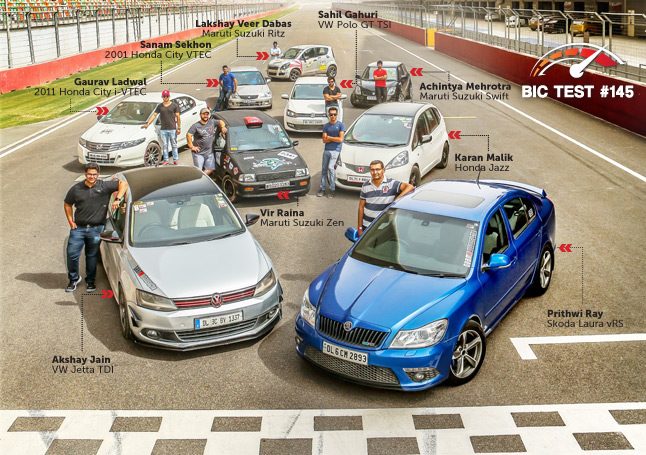
Each of these guys are regulars on the track day circuit. And thanks to the Buddh International Circuit, they often give their cars a proper workout. Not only is this fledgling car culture truly blossoming, but it’s doing so responsibly – by shunning street racing and ensuring that the right foot is exercised in a controlled environment.
But will they be okay with me exercising my right foot in their respective machines? After all, there are only two things that you don’t ask a man for – his wife and his car. And I don’t know if any of them are married, but I do know that each is incredibly passionate about his machine – and here I am explaining to them that I’ll be doing a couple of hot laps in each car while the V-Box logs some all-important data. Plus, it’s a very still 40-degrees – which means that the track temperature is about 50-degrees C. And because it’s in the middle of summer, the track hasn’t been getting much use – so the track surface is covered in a thick layer of dust. Not ideal conditions then.

I have to say, though, that each of these owners were incredibly sporting – and each encouraged me to really push their cars. Sure, they made sure to give me plenty of advice before going out – one had rigged the windshield washer to spray onto the radiator, while others had removed the rev limiter on their high revving engines, while the rest warned that I needed to keep an eye on the temperature gauge because of their large turbos and blueprinted engines.
And it’s quite a varied bunch that we have here. Vir Raina, who has plenty of racing experience under his belt – he’s also Director of the North for the FMSCI (Federation of Motor Sports Clubs of India) – was instrumental in making this test happen. He brought along his stripped out budget racer – a 1.6-litre Zen. At the other end of the spectrum was Prithwi, whose Laura is putting out a claimed 360 horsepower and 500Nm of torque.
But, there’s only one way to find out if these mods are any good – and that’s to thrash them on the track. So, let’s get to it.
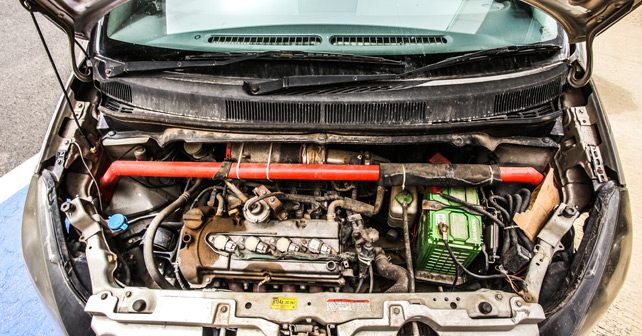
Now, a Maruti Suzuki Ritz doesn’t strike you as much of a track car – but Lakshay Veer Dabas would beg to differ. His Ritz has a ported and polished engine block, shaved head, Piper high-lift cam, and a full aftermarket exhaust and intake system. Currently, he’s running Bilstein B6 dampers all around – having recently removed a set of BC Racing coil-overs and a rear strut bar. His car’s not exactly discreet, as it’s covered in stickers from front to back – making this the very definition of boy-racer. Except that Lakshay’s Ritz backs it up with pretty impressive performance.
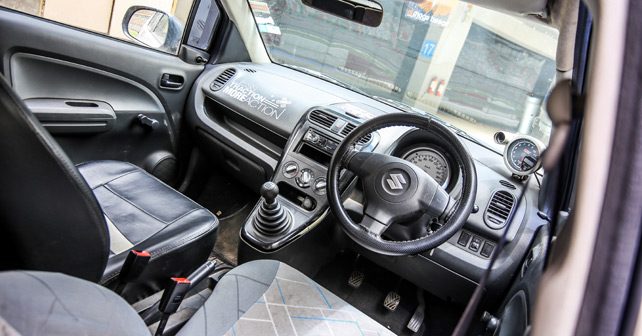
The great thing about the 1.2-litre, four-cylinder Suzuki motor in this car is that it’s virtually bulletproof. Since our tuners have so much experience in readying this engine for racing and rallying, modding it is a relatively easy process. So, whatever Lakshay’s had done, the end result is that it absolutely sings. Plus, I love the centre console mounted gearshift – it really is very touring car like, as it falls perfectly to hand. Where Lakshay loses out, though, is in the top-speed department. For comparison sake, the Ritz manages 143km/h down the back straight, while Prithwi’s Laura blurred the scenery all the way to a pretty steep 217km/h. The tall-boy design of the Ritz doesn’t exactly help aerodynamics. And the high centre-of-gravity doesn’t help vehicle dynamics either. This car turns in extremely well, but if you’re too aggressive the rear end can lose grip during the weight transfer and swap ends on you before you know it. So you do have to be a little careful, and avoid being overly aggressive at corner-entry. The coil-overs and rear strut bar – which would have tightened up the rear end – were certainly missed. But, on the whole, the car was extremely keen and stable. And there’s just something about these high-revving naturally aspirated engines – they’re intoxicating!
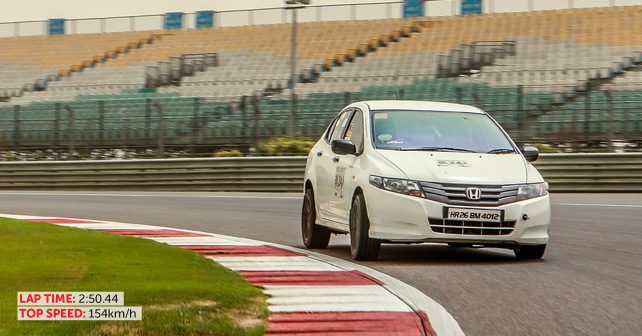
And speaking of high revving engines, next up is Gaurav Ladwal’s 2011 Honda City. Stock, the 1.5-litre, four-cylinder Honda i-VTEC engine produced a fairly timid 116 horses. And while we can’t be sure how much power Gaurav’s car is putting to the ground, you can bet that it’s substantially more thanks to the fact that it’s been ported and polished, as well as had the intake and exhaust completely redone. More importantly, though, it’s got a lightened flywheel and Exedy Stage 1 clutch. It also has a Dastek Unichip piggyback ECU – which regulates ignition timing, air-fuel mixture, compression ratio, etc. – a short ratio gearbox and a Tein coil-over kit tweaked by Red Rooster Performance in Bangalore. All this probably explains why this car just loved to be revved and pushed to within inches of its life.
It’s clear that Gaurav is pretty serious about performance, since this car has no rear seats or air-conditioning. And that perfectly defines what the majority of these cars are about. They’re not about showing off, or ferrying friends, or kerb appeal. Nope, they’re about all-out, raw performance. They’re entirely focussed, and it’s this focus that’s managed to turn a pretty dismal car – when it came out of the factory – into something that’s an incredible amount of fun to throw around a racetrack. Of course, it also had the dubious distinction of being the dustiest car here – I don’t think the cabin has seen a dust cloth since 2012! And that just gives you another indication of what Gaurav’s priorities are.
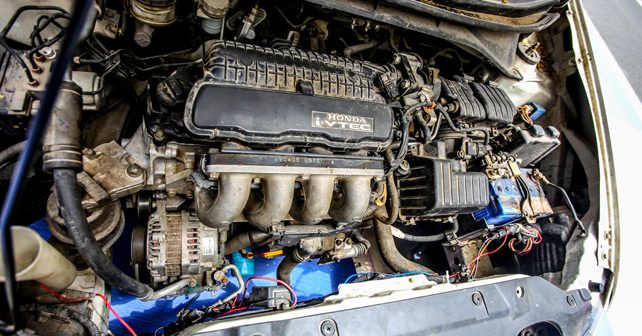
The key to driving this car fast is revving its nuts off, not braking very much, and carrying as much speed through the corners as possible – all actions that provide great enjoyment. You have to lift slightly to get some weight on the front before pointing it into the corner and then just keeping your foot planted – all the while you revel in the crackle and pop from the exhaust on the overrun, and the sound of music from under the hood when you’re on the power once again. And because it’s so light you can always adjust the nature of the car through the corner. These Hondas are cars in which you don’t have to hold back much. Which brings us neatly to Karan Malik’s 2009 Honda Jazz. He’s done a little more than just tune the engine. Nope, he’s decided to swap it out completely! In fact, he’s junked the 87bhp 1.2-litre engine that came in the Jazz and replaced it with the 1.5-litre from the City. Of course, it’s got a modded intake and exhaust – and, the next step, he says is forced induction. He’s also got Project Mu B SPEC brake pads, a Cusco rear anti-roll bar, and Tein springs.
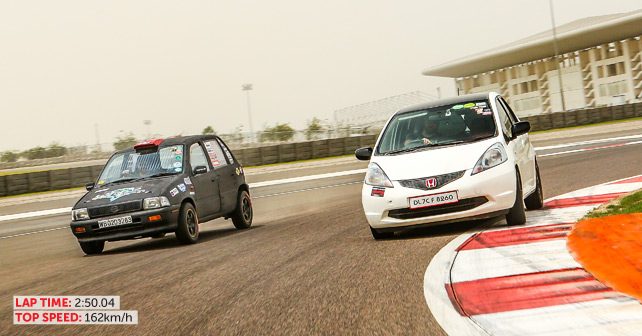
Several years ago, we did a ten-vehicle small car shootout, and the car that very nearly came out on top was the previous generation Honda Jazz. Even with its 1.2-litre motor, it had a racy nature. You could just sense – as you do with many Hondas – that there’s something a little bit special lurking underneath. You just have to goad it and fettle it a little to extract it. And that’s exactly what Karan has done with his Jazz. Fortunately, his car has a much better equation with a dust cloth than the City – and even had some nice upgrades in the cabin. The seats and door pads have some nice red inserts, while the gear knob was a shiny pink metal ball that enjoyed being rowed through the gates. In fact, the highlight of this machine was how the gear lever slid with absolute precision from one slot to another. It felt very Honda-like – as well it should be I suppose.
This car was always begging for a better engine, and Karan has done well to comply. The VTEC cam kicks in at about 5,000rpm, which causes this little Honda to surge forward. I have to remember to shift at 7,000, since there’s no limiter. The engine just sings, and it’s pure joy. But you have to work hard to extract power from it. We get so used to the gobs of torque in the mid-range of the various turbo-diesels that we drive these days that we forget the joys of having to keep the revs up to extract maximum performance.
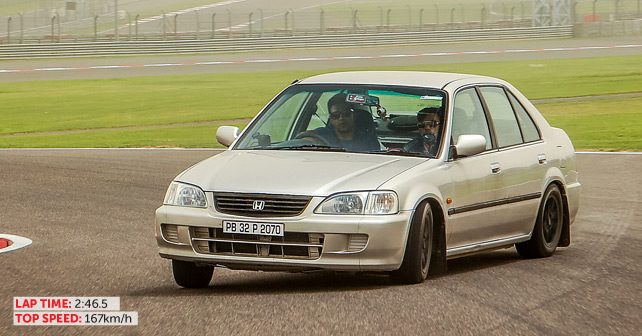
Well, extracting ultimate performance is something that Sanam Sekhon from Chandigarh knows a thing or two about. Sanam inherited this 2001 City VTEC from his grandmother – she had good taste in cars no doubt – and he was kind enough to drive all the way from his home in Chandigarh to join us for this test. As I slid into his Sparco racing seat, facing a tiny, three-spoke racing wheel, I felt like I had come home. I used to own a 2002 City, and I also had sports seats, an intake and exhaust, so this was like a blast from the past. Only better. Much better!
You see, Sanam has a bunch of Cosworth parts, MSD ignition, a larger throttle body and manifold, lighter flywheel and Stage 2 Exedy clutch on his City. He also has front and rear strut braces from Ultra Racing, an aluminium sump, Eibach springs, as well as upgraded brake pads and rotors – all of which made this one of the most involving and engaging cars of the bunch. I have to say that the one thing that stood out amongst the many mods in this collection of cars was that the machines that had an upgraded clutch and lightened flywheel were, naturally, far more free revving and that much more fun to have the rev needle dancing around the tachometer. And that’s what this car was all about – absolute, pure, unadulterated fun.
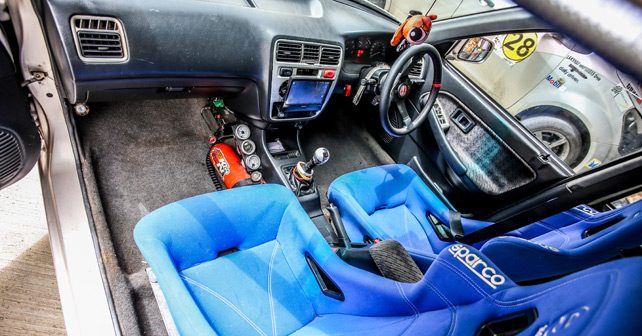
If you think about it, the VTEC City of the late 90’s was perhaps the first car that enthusiasts could really work with. And so this is a proper, old-school enthusiast machine that just makes you smile. The steering is hydraulic and oozing with feel – although it does get a little light off centre. Plus, the gearshift is a little notchy with long throws – but you can forgive these mild sins. This car is all about lightness, all about being pointy, and all about momentum. It’s all about driving the living daylights out of it! It’s got a really sharp front end. Before a corner, you hardly have to brake – you simply turn the wheel and add friction. And you can get on the power so early that it just makes you greedy for revs. You just don’t need big beefy tyres and massive brakes when you’ve got cars as light and chuckable as these.
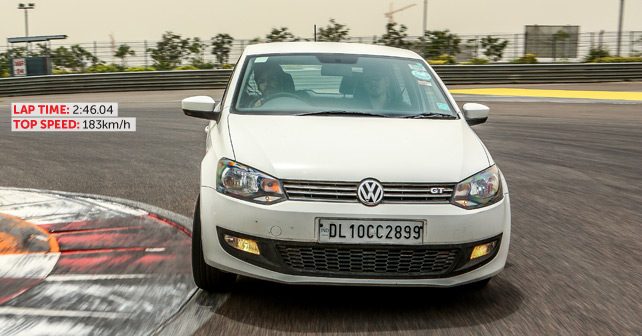
Speaking of chuckable, we couldn’t possibly do a test like this and not include a VW Polo GT TSI – the current favourite amongst enthusiasts around the country. I’ve had the pleasure of racing in the Polo Cup as well as the Vento Cup, so I know just how good this platform really is. With its 1.2-litre, direct injection, turbocharged petrol motor mated to a 7-speed DSG gearbox, this is the perfect everyday runabout. And the mods that Sahil Gahuri has made to his car have just taken it up a notch. Custom exhaust of course, as well as a Petes Stage 1 remap, and putting the additional power down are a set of BC Racing coilovers. Outwardly, this Polo looks completely stock – with the exception of a massive exhaust tip – so it’s the perfect sleeper car. Get going, though, and you immediately notice the difference. It sounds nice and deep throated. Get to the first corner, and you’re amazed at just how much more grip it has compared with a stock Polo GT. It’s a sign that a set of small modifications that can completely transform the character of a car. This is just so much more engaging and fun to drive compared to a standard Polo, and yet the car appears to be completely stock. The only thing it needs are a pair of more supportive seats – the factory seats are completely flat and not designed to deal with the kind of cornering loads generated by the upgraded suspension and tyres.
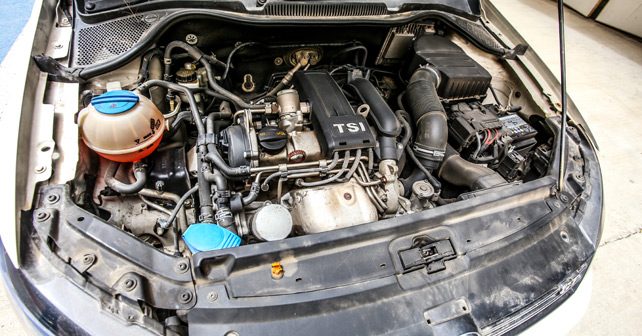
Now, if Sahil’s Polo appeared to be stock, Akshay Jain’s Jetta is absolutely at the other end of the spectrum. Splitters, diffusers, winglets, and forged alloys that weigh just 5 kilos apiece immediately give this car away as being a little bit special. And, like the Polo, the Jetta is a great platform to work with.
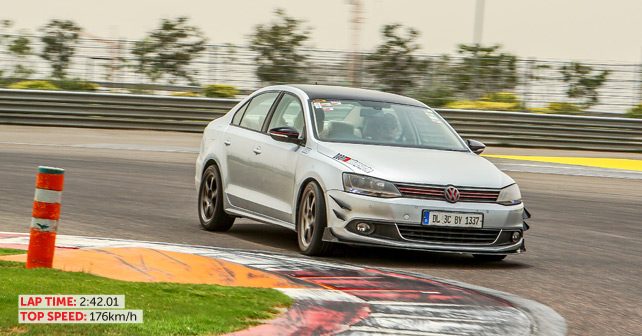
This one has a Custom Code 200hp remap, Decat custom exhaust and Magnaflow muffler. Bilstein B6 dampers and H&R springs, Hotchkis 27” sway bars, and Tarox brakes keep the 200 horses in check. My absolute favourite modification, though, are the paddles that Akshay has added to the steering. These DSG gearboxes are so good, but I find the manual shifting mechanism completely counterintuitive – so paddles are almost a must in a car like this. And these work incredibly well. Like the Polo, this car provides a near perfect combination of everyday usability and performance. Like its stock version, this car is very comfortable and easy to live with. Step on it, though, and engine remap takes over. Once on boost, the engine is very linear and the gearbox is brilliant. The front end is a little heavy though – with the 2.0-litre TDI motor lurking under the hood – but turn-in is very sharp and it corners completely flat. It was running a little hot mind you, so Akshay says his next mod is to add an intercooler. All told, this is a very civilised way to have fun.
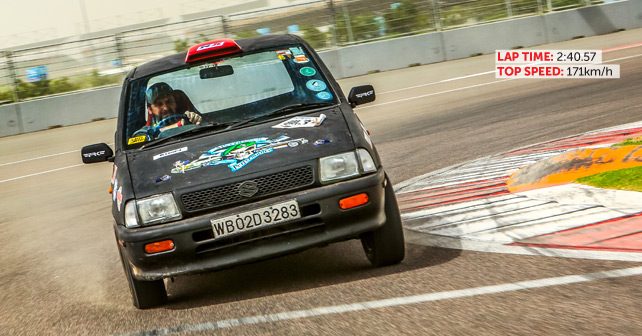
And this is not – this is Vir’s budget-racer Zen! This thing is as bare bones, raw, and balls out as you can get. Gone is the Zen’s 1.0-litre carburetted motor, and in comes a 1.6-litre fuel injected petrol engine that gives this Zen some serious get-up-and-go. It’s also been ported and polished and gets a high-lift cam for good measure. Of course, it has a custom intake, larger throttle body, headers, exhaust, as well as a short ratio gearbox and lightened flywheel. A Racing Dynamics ECU ensures that it’s producing all the power it can muster. And helping matters considerably is a stripped out interior and – get this – fibreglass bonnet, rear doors and boot lid. Honestly, the best way you can get a car to perform better is to make it lighter. And the best way you can make it give the racetrack a bear hug is by putting on a set of racing slicks – which is exactly what Vir has done here.
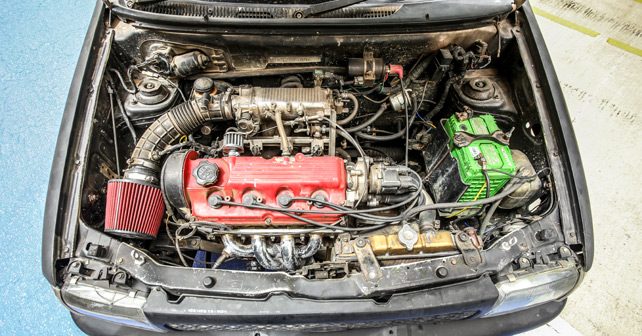
I jump in, squeeze myself into the racing bucket, strap myself into the four-point racing harness (which, incidentally, came out of my old rally Gypsy), and crank the motor – which feels lumpy and fussy at idle. Ease out the clutch gently, and, wham, even at 2,000rpm your senses are overwhelmed by the sweet cacophony of engine and exhaust. You can no longer hear yourself think. Instantly, it blows your eardrums and gets under your skin – in the best way possible. I hit the gas on the back straight, and the stock speedo needle is off the charts at 160km/h. I can’t help but laugh. I get to C4 at the end of the back straight only to find that the brakes are pretty good. But, then, you don’t really need brakes in this machine because it has so much grip on these slicks. On the next flying lap, I have the best two-minutes-and-forty seconds of my life. Who knew you could have so much fun on such a tight budget? And, for that alone, this car is a revelation – it’s mental!
Speaking of mental – how about a front wheel drive family sedan producing a claimed 360bhp and 500Nm from its 1.8 turbo-petrol motor? Welcome to the world of Prithwi Ray – a world that consists of a lot of wheelspin. Really, a lot!
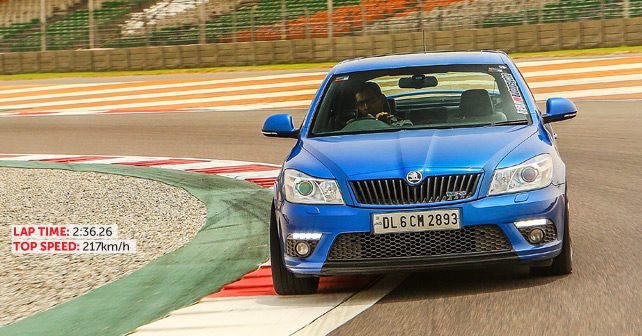
This Laura, in vRS spec, was beautifully kitted out – right from the beautiful alcantara Recaro seats, door pads, and dash trim, to the perforated leather steering wheel. It sits very squat on a set of forged Borbet wheels that are wrapped in sticky 245/45 R17 Continental tyres. It produces its power courtesy of an APR K04 turbo kit, a Milltek non-resonated turbo-back exhaust, APR Carbonio carbon fibre intake, Integrated Engineering intercooler, and all other manner of special tubes, pipes, valves, wires, plugs and ECUs. The remap is designed to run on 95-octane fuel, and the manner in which it sips said fuel means that Prithwi obviously spends a lot of time at the Speed-97 end of a select few petrol pumps in the Capital. A Bilstein coilover set attempts to deal with the ferocious power, while Tarox brakes with six-pot calipers in front attempt to get it all under control again. Even all the transmission and engine mounts have been upgraded – with first-rate parts specific to this machine of course. And boy does this car need the upgraded clutch and single mass flywheel that it gets. The stock clutch would melt in a matter of minutes with the amount of power and wheelspin that this machine generates. Before I go out, Prithwi asks me to disengage the traction control – not because he has faith in my driving abilities, but because if the traction control system attempted to reign this car in on the track it would simply melt the brake pads in less than a lap.
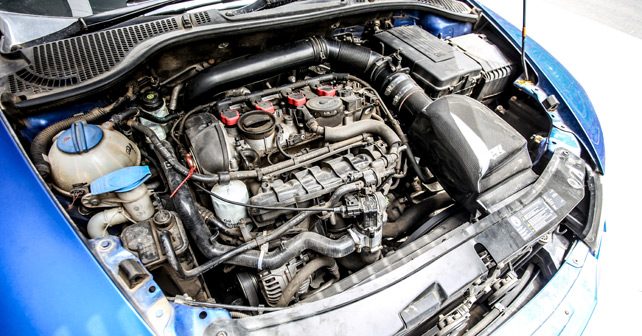
On the back straight, on my out lap, I’ve already exceeded 200km/h. The brakes, thankfully, are solid. The pedal is very firm and the stopping power very reassuring. Through turns five-to-eight you get constant wheelspin, even at part throttle. In fact, you can hold the throttle at 40-percent, and just glide the car from apex to exit with the front wheels spinning. Straighten the wheel, though, and the power is explosive. Fortunately, the chassis has no trouble dealing with the speeds generated by this motor. It corners completely flat – even when you’re going through a corner with full opposite lock on, it’s completely balanced. Whoever set this car up knew what they were doing. The key with this car is to brake early, be smooth through the corners, and then absolutely destroy the next straight thanks to the insane power produced by this turbo – which is running at 26PSI. You have to short-shift in second because otherwise the 245’s don’t stand a chance, and you have to keep an eye out on the temperature gauge – especially in this weather. So, I had my work cut out for me while lapping this car. There’s no doubt that in better conditions, and with a little more time behind the wheel, it would be considerably faster. The power it produces and the way it revs simply beggars belief. And the fact that it can do so reliably in the middle of summer is a testament to the quality of the parts and the workmanship. It’s a laugh a minute this car – but clearly it prefers going straight.
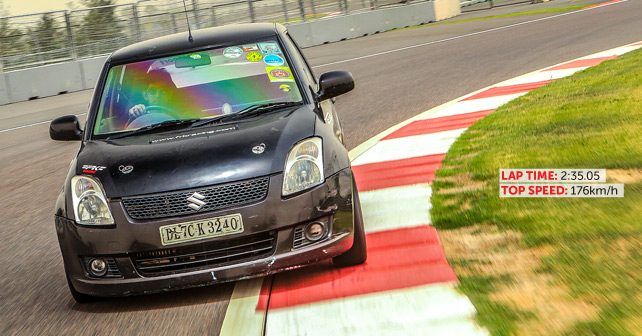
The fastest car here, though, is one that simply devours corners. Here at autoX we’ve always loved the Swift for its playful nature, and the way its stubby gear lever tore through its ratios. It was always like an eager little Terrier straining at the leash while you negotiated traffic. Suzuki had the Swift Sport in the West, but – sadly – never brought it to India. That doesn’t concern Achintya Mehrotra though, he’s gone one better. This unassuming black Swift, which Achintya refers to as Kalli Billi, really is a ‘Black Cat’ – in that you simply don’t see it coming until it pounces on you. The first time that I hit the gas, I was shoved into my seatback as Kalli Billi squatted and simply took of. You see, this 1.3 Suzuki motor has a turbocharger slapped onto it by FRK Racing in Bangalore. Fortunately, it also has a Cusco LSD (Limited Slip Differential) to help the front axle transmit the power to the track surface. It also gets a set of slicks to aid in this process, and, of course, front and rear strut braces, coilovers, upgraded brakes, and the magic formula – fibreglass rear doors, hood, and boot lid.
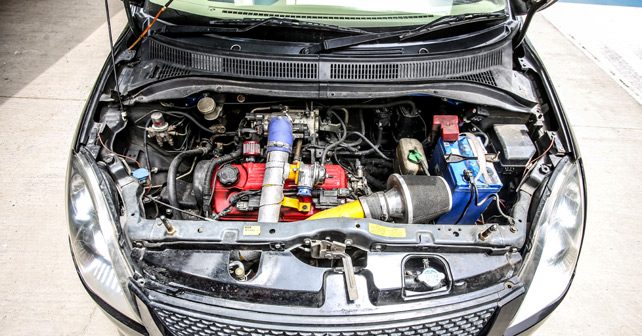
All of this adds up to create a car that’s far more than the sum of its parts. The steering tugs at you a little because of the LSD, but otherwise it’s just point-and-shoot – you simply turn the wheel, plant your foot, and the car sorts out the rest. The power from the turbo is amazing, and the grip from the slicks is equally impressive – creating a really balanced machine that corners completely flat and simply carries so much more speed through the corners than any other machine here (something that’s validated when you look at the telemetry graph). It’s race-car stiff, this machine. In fact, it would make a great platform for a one-make racing series. It’s not delicate mind you, you do have to muscle it a bit. It’s got a loud whoosh from the turbo, a slightly tail-happy nature, and you have to fight the steering wheel a little bit, but – at the end of the day – it’s a really special machine. A machine that perfectly sums up what we’ve learned here today – this is not a beauty contest. This is about putting your money where your mouth is, about really carving corners, flying down straights, and plastering the biggest smile that the driver can muster. And, on that count, every single car here is a winner.
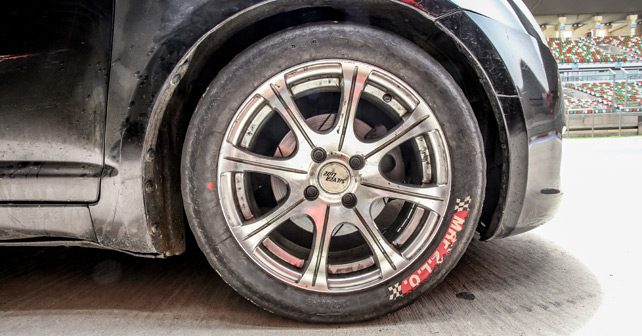
In fact, these guys have proven that the car culture in India is not only thriving and imminently accessible, but it’s actually quite evolved. Not one of these cars complained at all despite the weather. This not only points to the fact that modern cars are incredibly reliable, but also to the quality of the craftsmanship available in the tuning fraternity in India. This test also firmly establishes what we set out to prove at the outset – that you don’t have to spend a fortune to have a blast behind the wheel of a car on a race circuit.
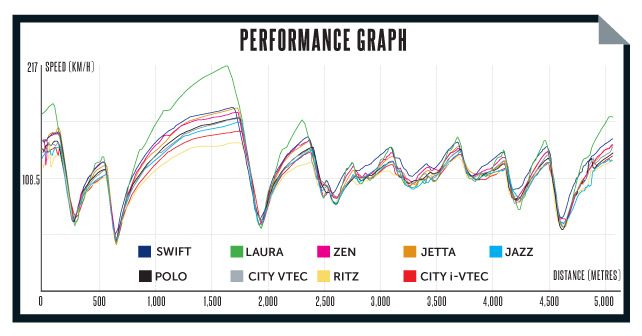
We’ve tested a lot of big, expensive and exotic machinery at this track, and as far as fun factor is concerned, frankly, I can’t quite remember having had this much fun – with the exception of a few truly classy motors, like the Porsche 911, Mercedes-AMG GT, Audi R8, or BMW M3 perhaps.
So, what are you waiting for? Go and draw up that list of mods that you too can make to your ordinary, mundane, family hauler. Go and live a little – like this lot! Thank you chaps…
| CURRENT TESTS | Lap Time | Top Speed |
| Maruti-Suzuki Swift | 2:35.0 | 176 (Km/H) |
| Skoda Laura vRS | 2:36.3 | 217 (Km/H) |
| Maruti-Suzuki Zen | 2:40.6 | 171 (Km/H) |
| VW Jetta TDI | 2:42.0 | 176 (Km/H) |
| VW Polo GT TSI | 2:46.0 | 183 (Km/H) |
| 2001 Honda City VTEC | 2:46.5 | 167 (Km/H) |
| Honda Jazz | 2:50.0 | 162 (Km/H) |
| 2011 Honda City i-VTEC | 2:50.5 | 154 (Km/H) |
| Maruti-Suzuki Ritz | 2:54.7 | 143 (Km/H) |


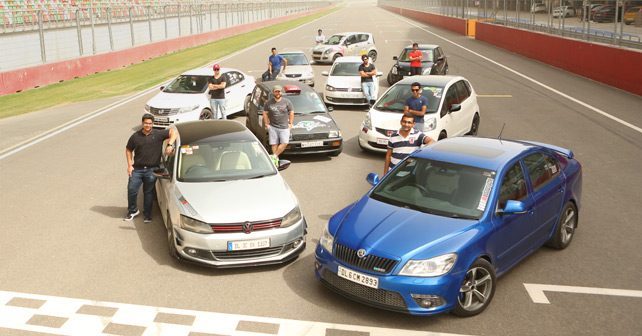
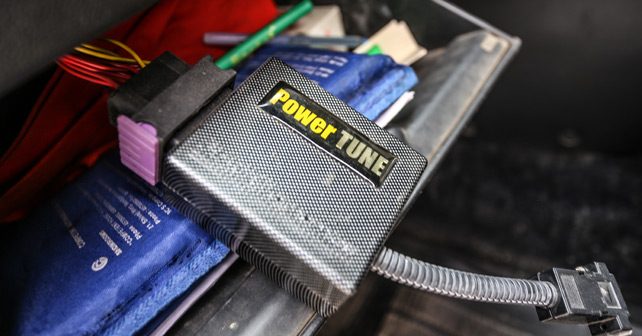
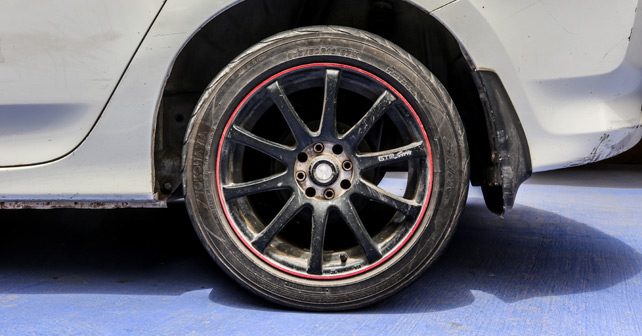
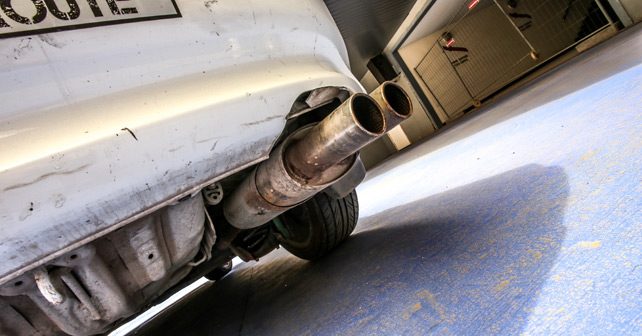
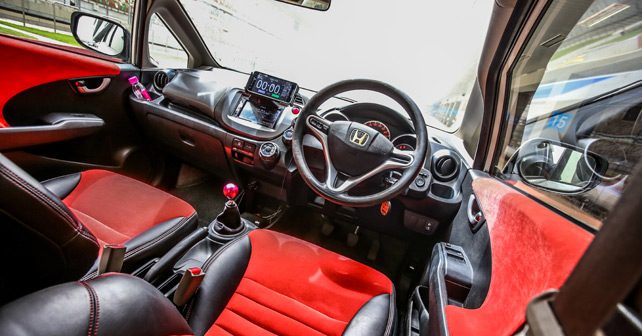
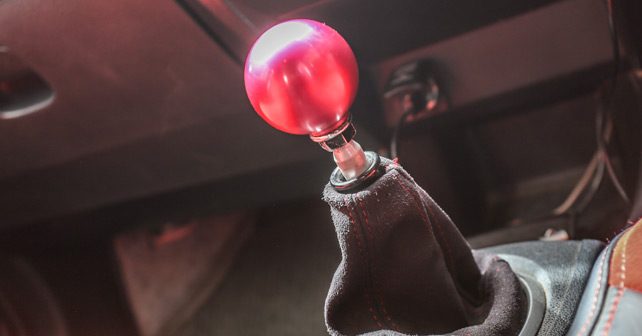
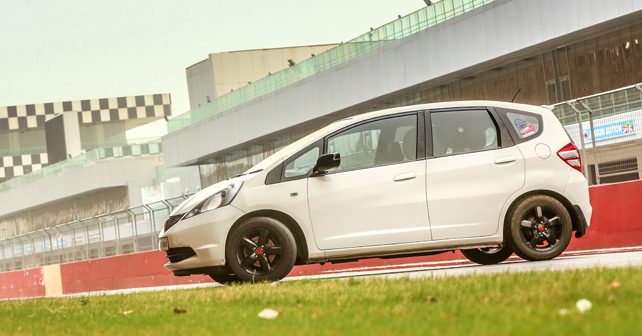
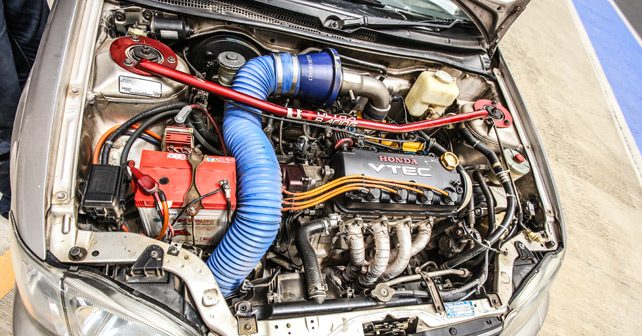
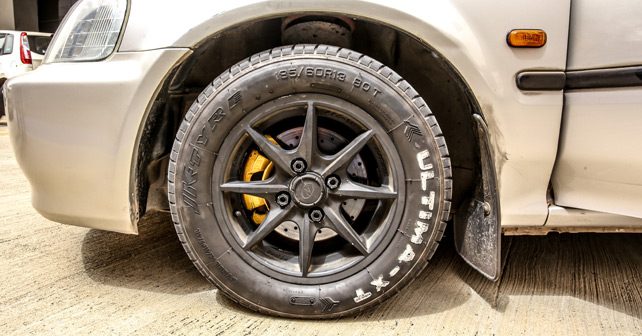
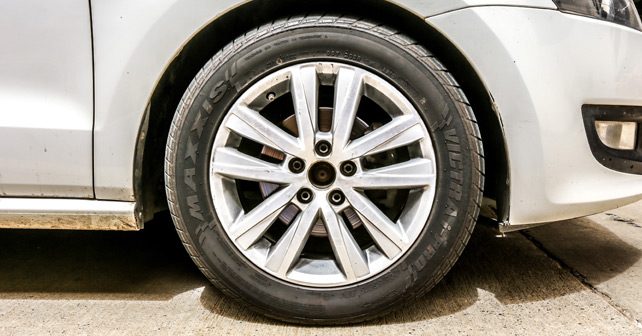
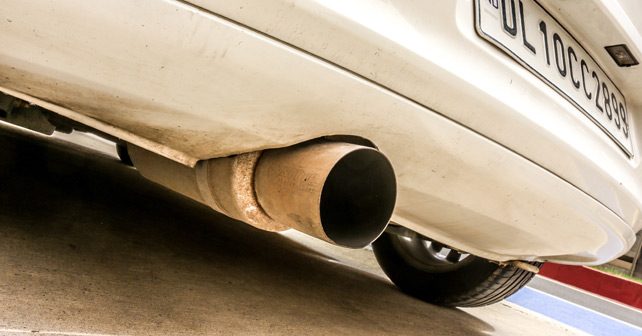
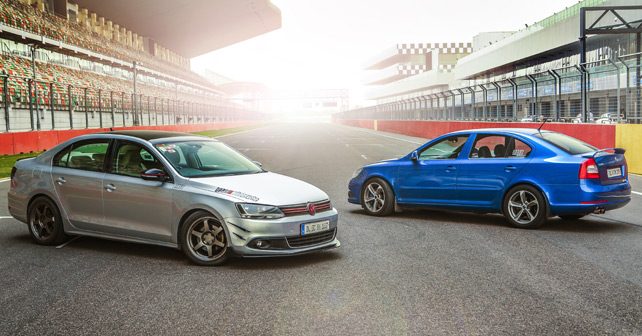



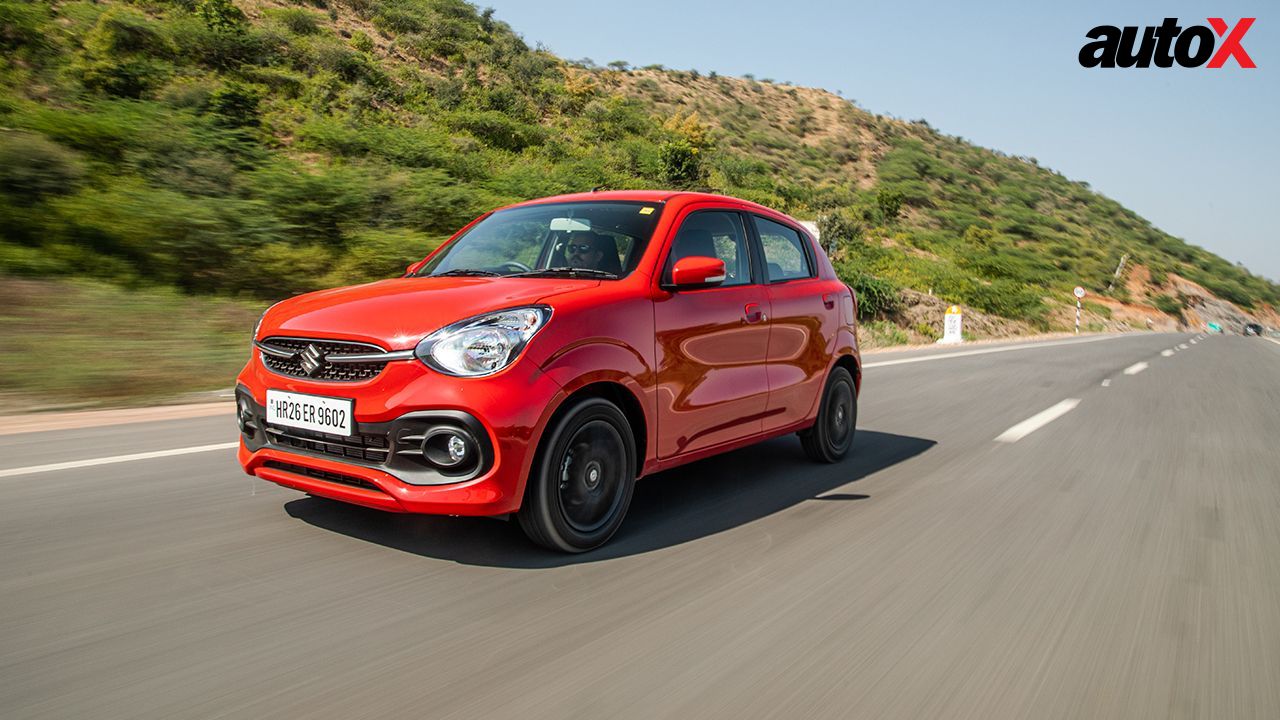
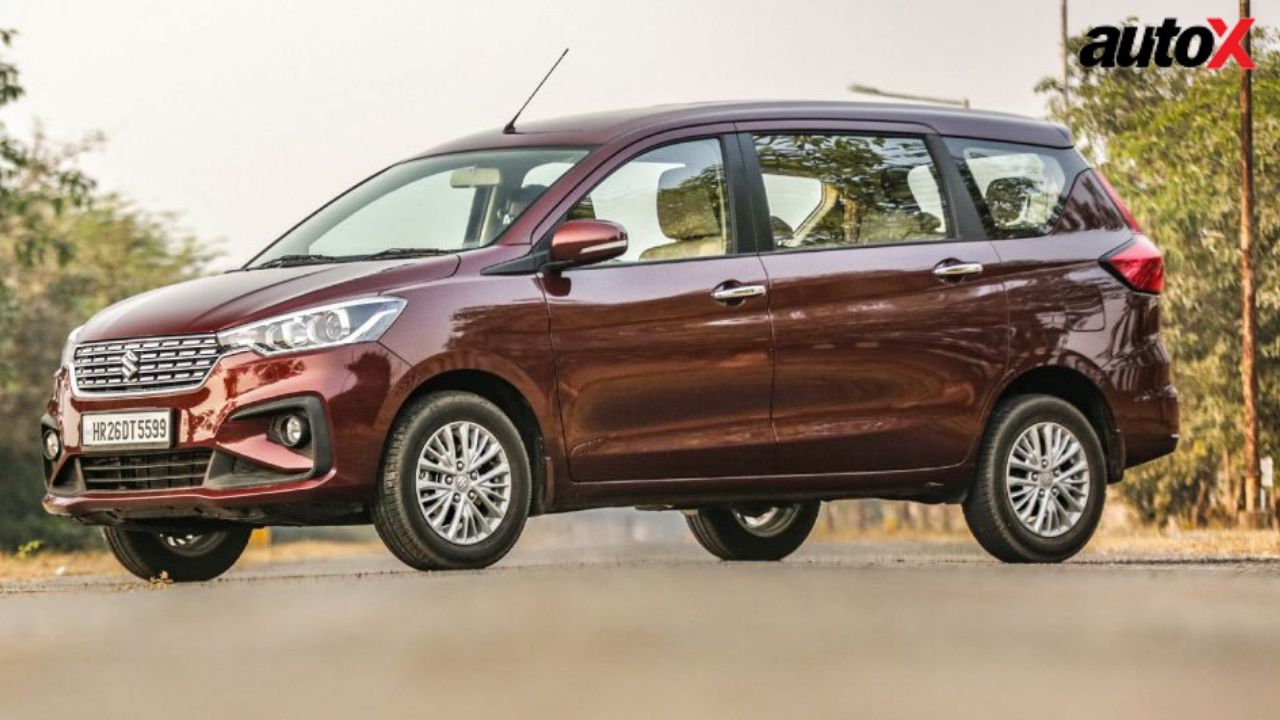
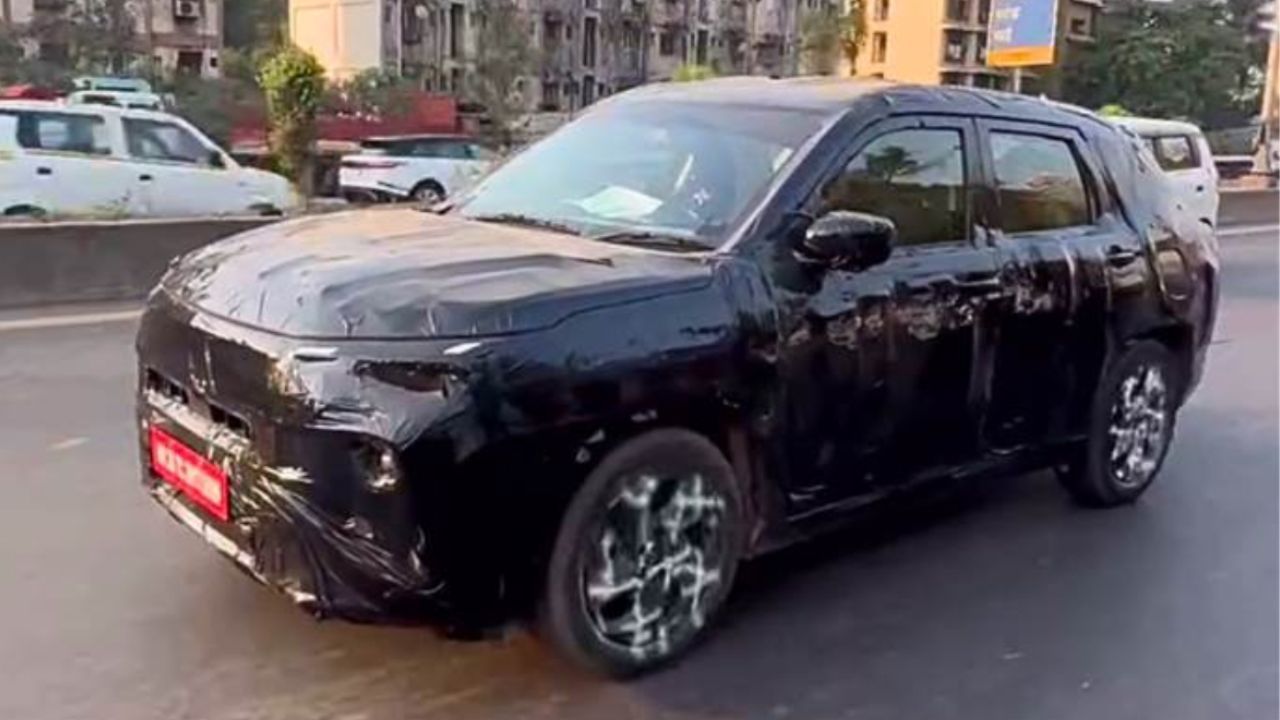

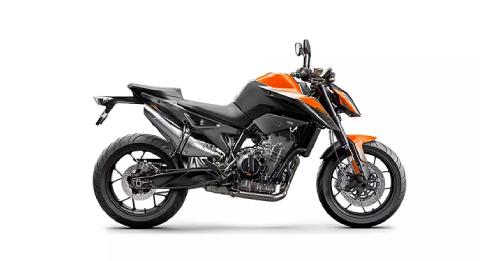
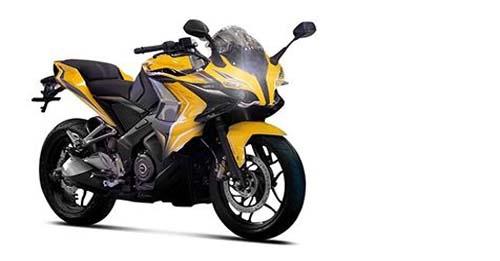
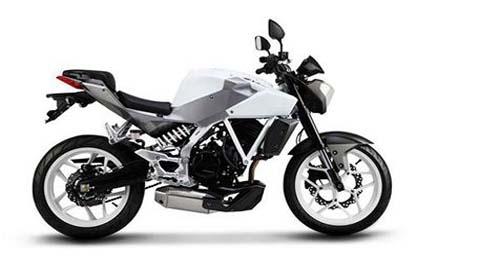
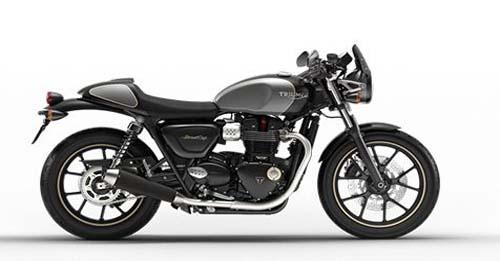


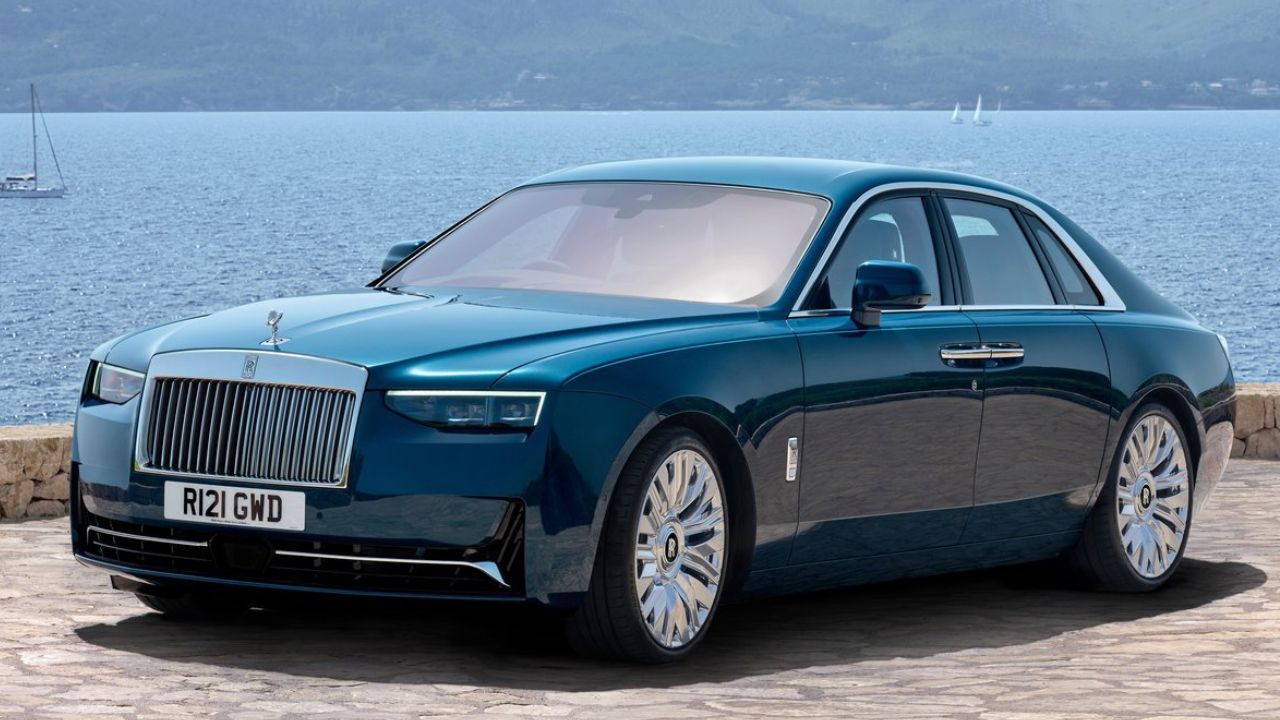
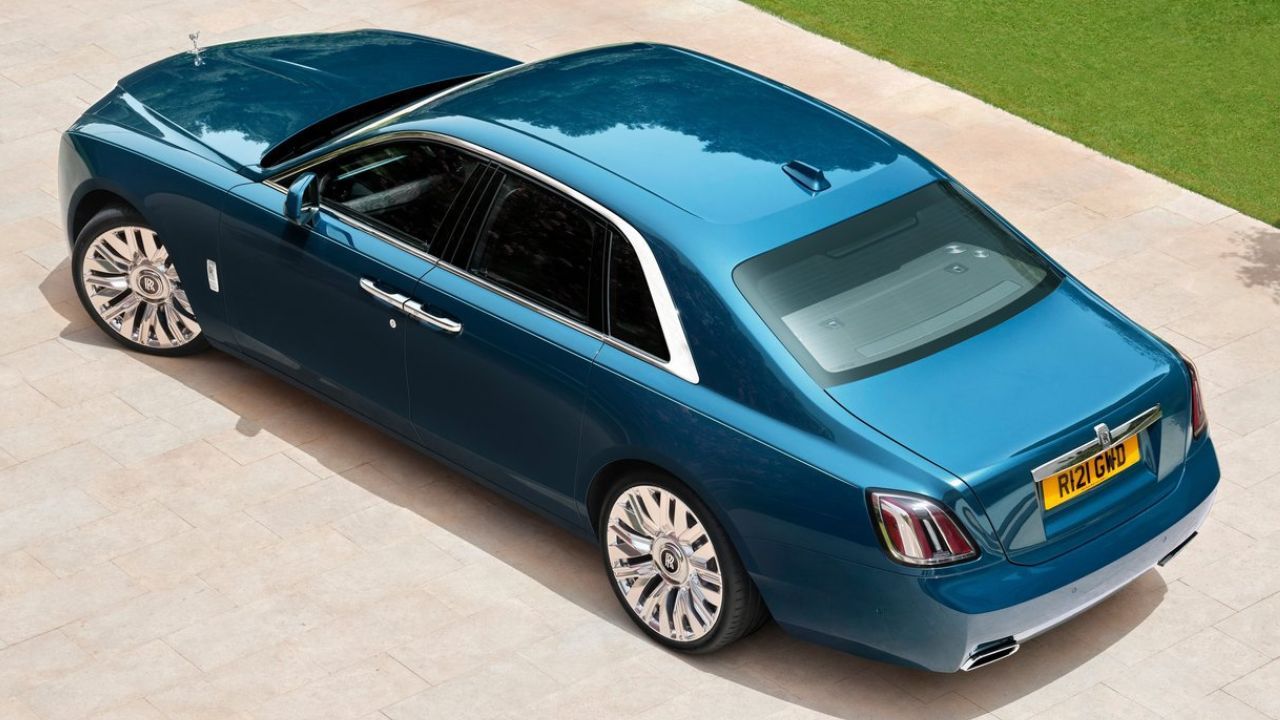
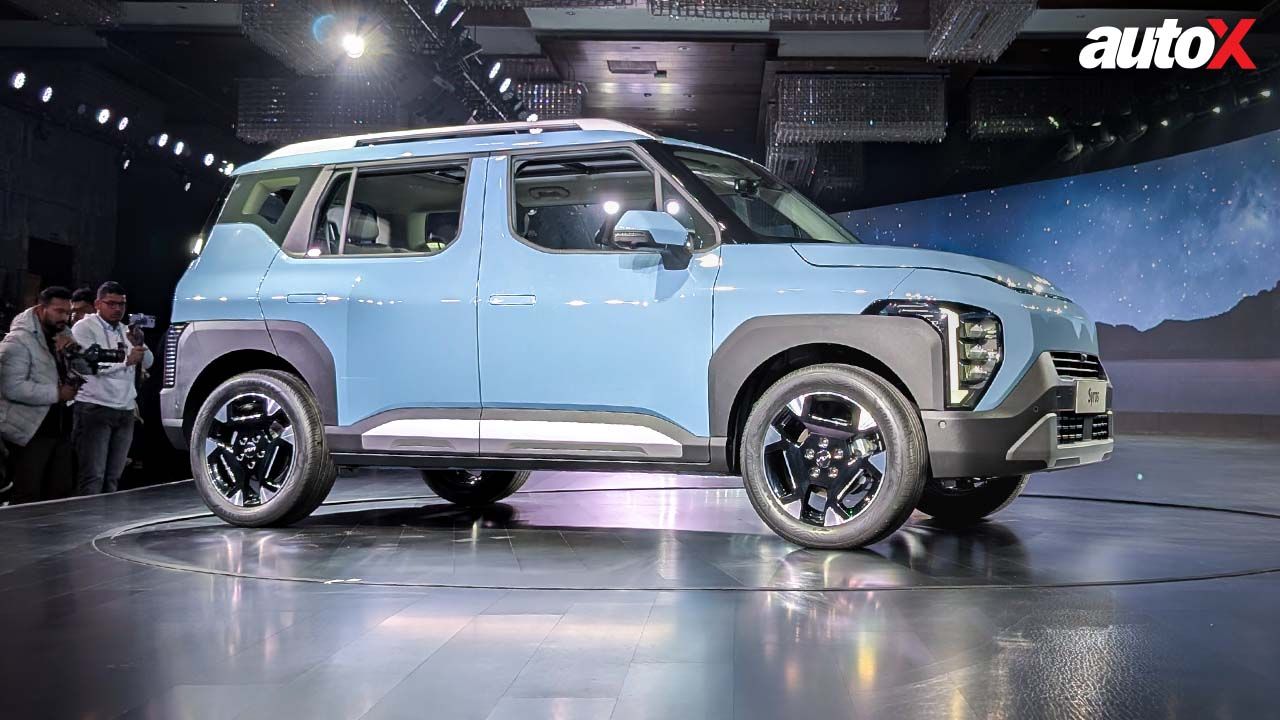
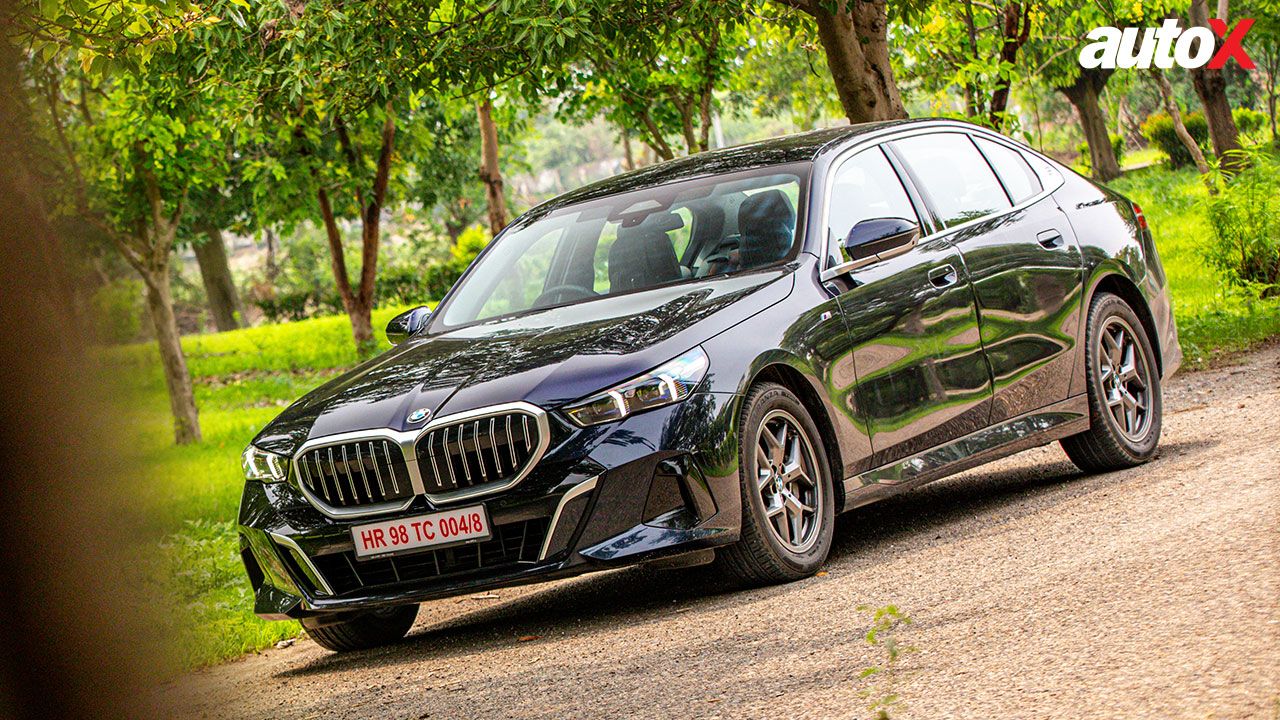
Write your Comment on